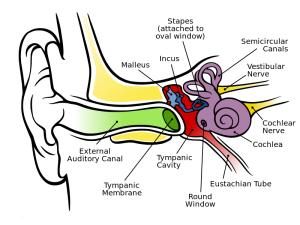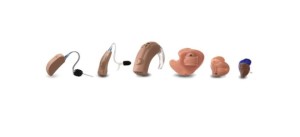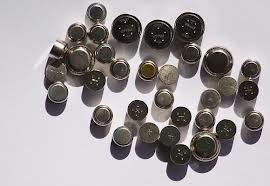“What did you just say?” Hearing and Hearing Aids
“What did you just say?”
Hearing and Hearing Aids
Author: Mark Parkinson RPh: President AFC CE
Credit Hours 1. - Approximate time required: 60 min.
Educational Goal:
Provide caregivers with a basic understanding about hearing and how to take care of hearing aids.
Educational Objectives:
1. Describe the anatomy of the ear
2. Describe the physiology of hearing
3. Explain about ear wax from a caregivers perspective
4. Expound about the basics of hearing aids and their care
Procedure:
1. Read the course materials. 2. Click on exam portal [Take Exam]. 3. If you have not done so yet fill in Register form (username must be the name you want on your CE certificate). 4. Log in 5. Take exam. 6. Click on [Show Results] when done and follow the instructions that appear. 7. A score of 70% or better is considered passing and a Certificate of Completion will be generated for your records.
Disclaimer
The information presented in this activity is not meant to serve as a guideline for patient management. All procedures, medications, or other courses of diagnosis or treatment discussed or suggested in this article should not be used by care providers without evaluation of their patients’ Doctor. Some conditions and possible contraindications may be of concern. All applicable manufacturers’ product information should be reviewed before use. The author and publisher of this continuing education program have made all reasonable efforts to ensure that all information contained herein is accurate in accordance with the latest available scientific knowledge at the time of acceptance for publication. Nutritional products discussed are not intended for the diagnosis, treatment, cure, or prevention of any disease.
“What did you just say?”
Hearing and Hearing Aids
 |
Caring for people in a home (non-institutional) setting can be challenging at times. Caregivers take on the responsibility for looking out for ALL of their clients’ needs. Suddenly, you must know what to do about… well, everything. For example, all care providers have to know how to maintain, handle, and clean the hearing aids of their clients. Too often, however, the owner’s manual is long gone. How are you supposed to know what to do? Hopefully, by the end of this article, you’ll have the answers you need.
Hearing loss is more common than you might think. Ten percent of Americans - about 30 million people - have hearing loss. That figure is going to rise as noise exposure, trauma, disease, heredity, and the aging process all take their toll. In the care home setting, the incidence of hearing loss is much higher than the general population. It is increasingly common even at homes for the developmentally disabled and mentally ill to have to deal with hearing impaired clients and hearing aids. How do you take care of the hearing impaired and their hearing aids?
The Anatomy of Hearing
 |
Let’s start with an understanding of hearing and hearing loss. Hearing is the process of turning sound waves into nerve impulses that our brains can comprehend. How that happens is very interesting. The ear is comprised of three parts called the auditory system:
· The outer ear, which is made up of the pinna (the portion of the ear outside the head) and the ear canal.
· The middle ear, which contains the eardrum and an air-filled chamber that houses three of that smallest bones call the ossicles.
· The inner ear, or cochlea, which is a spiral fluid-filled chamber filled with tiny hair like structures connected to the nerves responsible for hearing.
How we hear
Sound travels through the air in waves. These waves of air pressure are collected by the pinna and travel down the ear canal. The waves strike the eardrum and cause it to vibrate, which, in turn, causes the ossicles to also vibrate. This converts the sound waves into mechanical energy. That energy strikes the fluid-filled inner ear and creates waves that travel down the spiral. When the waves reach those tiny hair like structures they bend over, causing the nerves to fire. The combination of intensity and frequency of the waves determines which nerves fire, creating the nerve impulses we perceive as hearing.
Hearing is more than just nerves firing. It is also an active process of understanding what we hear. To do that, our brain collects all input it receives and combines it to better understand what it is listening to. Sight, smell, touch - all the senses - affect how we understand what we hear. We can even focus on a particular sound, filtering out competing input as background noise. It’s truly an amazing ability.
Protecting the Auditory system
Our ears are a complex system of interrelated parts, all working together. To protect it, the body does several things.
· The outer ear is lined with hairs that keep out foreign objects.
· Specialized sweat glands produce ear wax or cerumen that traps particles and dirt and gradually moves them out of the ear.
· The eardrum itself creates a barrier that nothing gets past.
· The delicate inner-ear parts are surrounded by boney structures that protect them from damage.
As you can imagine, with a system as complex as the ear, things can and do go wrong. If any part of the system is clogged or damaged, hearing is impaired. The causes of hearing loss fall into three categories.
· Conductive hearing loss arises from an interruption of the sound waves traveling through the outer or middle ear. Common causes would be earwax build-up, a torn ear drum, or fluid or infection in the middle or outer ear.
· Sensorineural hearing loss occurs when auditory nerves fire incorrectly. It arises mainly in the inner ear and is the result of damaged hair filaments or nerve fibers. Common causes are excessive noise, trauma, disease, or old age. Sensorineural is also called nerve deafness.
· Mixed hearing loss is a combination of both conductive and sensorineural hearing losses.
Caregiver notes:
Ear wax
There are many causes of earwax build up. Dead skin layers can accumulate, hearing aids can gradually block the natural process of removing cerumen, Ear hair can grow too long. An immobile or sedentary lifestyle can reduce earwax movement. All result in poor hygiene. As you go about your caregiving duties, don’t forget the ears. Keep them clean and trimmed. But be careful: Eardrums can be torn, scratches can become infected, and fungi can grow in an overly moist ear canal. It is even possible to clean the ear too much. The ear needs some earwax as a barrier against bacteria, fungal spores, and other foreign material. Ironically, mothers who keep their children’s ear canals too clean actually create more ear infections in their children.
Earwax removal products
Occasionally, you may need to buy an earwax-removal product. There are some controversial questions for caregivers to consider:
· Do you need a doctor’s permission before using an earwax-removal product? In my opinion, you can keep yourself out of trouble by getting a doctor’s OK. An easy strategy is make it a part of the doctor’s standing orders.
· Which product should you buy? Fortunately, all OTC products have the same active ingredient. Choose whichever is cheaper and follow the instructions.
· What about ear candles? Avoid them - always. There is something about putting an open flame and hot wax even near the ear just screams LAWSUIT when things go wrong.
· What if OTC products don’t work (I had a few new move-in clients that were that bad) Let the doctor handle it. That’s what they’re there for, right?
Compensating for Hearing Loss
As mentioned above, hearing is more than just auditory nerves firing. It’s a process of actively combining all inputs and filtering out unneeded stimuli. When the client’s hearing is impaired, you can take advantage of all the other hearing factors, so that you can be heard.
· Get the client’s attention first.
· Stand in front of the patient so he/she can see your face.
· Remove or limit distractions and unwanted noise.
· Give visual clues about the subject matter.
· Talk in a lower-pitched voice (high-pitched sound is the first to go in normal hearing loss).
· Talk slowly to give the client more time to process the sound input.
· Get closer, to make it easier for the client to focus on what you are saying.
· Don’t chew gum when talking - it changes the way your mouth looks when talking.
Hearing Aids
 |
Most hearing loss can be mitigated, but not cured. Some medical procedures can alleviate conductive hearing loss. However, nerve deafness, which makes up about 90 percent of hearing losses, is permanent. Most deafness comes on gradually with most patients suffering only partial impairment.
Those who do not seek help tend to become depressed, paranoid, insecure, and emotional. Although sight connects you to the world, hearing connects you to people, so those with hearing losses tend to become socially isolated. With the help of hearing devices, most of those effects can be avoided or eliminated. The hearing aid connects you back into the world.
There are several kinds of hearing aids. In general, the smaller they are, the fewer features they have and the more expensive they are. Also, the smaller the batteries are, the more frequently they must be changed.
· Behind-the-ear (BTE) aids use a case filled with the electronics that goes behind the ear, a connecting tube and an ear mold or dome. They are generally more durable and have room for larger batteries and features.
· In-the-ear (ITE) aids put all components in the ear mold itself.
· In-the-canal (ITC) aids are generally smaller versions of ITEs.
· Completely-in-the-canal (CIC) aids are the smallest type.
· Cochlear implants are surgically implanted devices that bypass damaged ear parts and feed electrical signals directly to auditory nerves
· A bone-anchored hearing aid (BAHA) is surgically connected to the bones of the skull. This allows the skull to be the pathway of sound into the inner ear. It is used in patients with conductive hearing loss, such as a child born without ear canals.
How do hearing aids work?
The basic hearing aid has four main parts: a microphone to pick up the sound of the environment, an amplifier that magnifies the sound, a receiver or speaker that changes the electric signal back into sound that is directed into the ear, and a battery that powers the device.
Hearing aids can’t totally replace normal hearing activities. They only supplement what remains of the patient’s original hearing. Hearing aids sound different than normal hearing and they take some getting used to. The patient must also get used to the feel of the devices in the ear. Because of the small size of the devices, patients must get used to keeping track of them. It is far too easy to lose a hearing aid at bedtime or during bathing. Since they are electronic devices, the signal can produce feedback, creating a high-pitched whining noise. That feedback whine can be a sign of ill-fitting or improperly worn device.
Accessories
In addition to their basic function of amplifying sound, hearing aids can also offer many extra features. Directional microphones allow you to hear sound directly in front of you better. Telecoils helps patients use phones better. Other features are low-battery indicators, automatic volume control, earwax guards, and manual volume control. Some devices even include a connection port that allows the wearer to plug into other sound devices like a radio.
Cost
Hearing aids can be one of the most expensive of your client’s possessions. The average cost can be between $1,000-3000 (and sometimes a lot more). You must also factor in the cost of visits to a hearing-aid professional and batteries that will be used. Most costs are not covered by traditional insurance. You can buy less expensive OTC hearing aids, but they will not be custom fit, so there will be comfort and feedback issues. Most hearing aids last between five to 10 years.
Batteries
 |
Hearing-aid batteries are tiny. Don’t force them into the device. They last between five days to a couple of weeks. The smaller they are, the faster they run out. Battery size is determined by a number, such as No. 612. Swallowed hearing aids can cause serious damage.
Hearing Aid Professionals
Regular hearing aids are considered Class I medical devices and are regulated by the U.S. Food & Drug Administration. As such, state governments license hearing-aid professionals. It is rare, but some family doctors (usually in very rural locations) can sometimes handle hearing aids. Ear, nose and throat specialists (Otolaryngologists ) also dispense the devices. Most hearing-aid professionals are either Audiologists or Hearing Aid Specialists. An Audiologist is the better trained of the two (look for “Au.D.” after the name).
Caregiver notes:
When you take care of a client who uses a hearing aid, you must take care of the hearing device, too. That means you must keep track of it, supply it with fresh batteries when needed, maintain it, and keep it clean. Sometimes, you can get the client’s relatives involved, but be careful: It often just makes things more complicated. Some tips:
· Provide a special container for the hearing aid when not in use (e.g. at bath time).
· Create a battery-replacement schedule.
· Double-check for proper fit if the hearing aid whines.
· See if the hearing aid has different programs built into it, then select the right setting (Example phone use).
· Negotiate with an independent Audiologist can be dickered with to obtain lower prices for clients.
· Disconnect batteries when the device is not in use to make them last longer.
· Remember to turn off the hearing aid when not in use.
· Excess heat makes batteries die sooner. Be careful with battery storage.
· Mark the battery-change date on a calendar to remember when to change.
· Remember, a properly fit and functioning hearing aid makes it much easier to communicate with and care for your client.
· Audiologists sell used hearing aids that are cheaper.
· Liquids, soaps, solvents, and water (even sweat) are the enemy of hearing aids.
· Hearing aids typically include a trial period where the hearing professional can make adjustments. Have patience with your clients. But if needed, send them and their devices back to the audiologist.
· Hearing aids are electric machines and must be periodically checked and cleaned by professionals. Frequency of maintenance depends on the brand and the owner’s ability to pay.
· Wipe the device dry - never use a blow dryer or a microwave to dry a hearing aid
· Remove the hearing aid first if you’re applying any lotions or liquids near the ear, including perfume, cosmetics, insecticide, cologne, or hair spray.
How to clean a hearing aid
Follow the specific instructions from the manufacturer. The client’s hearing aid professional will be able to tell you the brand and type. In general:
· Wipe the hearing aid daily with a soft cloth.
· Clean the device over a soft surface, so if you drop it, it won’t get damaged.
· Wipe the batteries if moisture is present.
· If the client doesn’t have a multitool for cleaning consider buying one.
· Use the wax pick to remove earwax buildup.
· Use the brush to clean vents and sound outlets. Never insert anything into the sound outlets unless instructed by the manufacturer
· Replace wax filters as directed and as needed
· Replace the dome as needed (every four weeks) if there is one.
 |
Conclusion
The ability to hear is an important measure of your client’s quality of life. Communicating with your clients is an essential element of caregiving. When hearing becomes impaired, quality of life decreases and caregiving becomes more difficult. Hearing devices help bring life back to normal for your clients. To operate properly, hearing aids must be properly understood, used, and maintained by the client and the caregiver.
I hope you found this article useful and, as always, good luck in your caregiving.
Mark Parkinson, R.Ph.
References:
1. Hearing Loss. Nation Institute of Health, Senior Health.
http://nihseniorhealth.gov/hearingloss/hearinglossdefined/01.html
2. Hearing Loss. Mayo Clinic.
http://www.mayoclinic.com/health/hearing-loss/DS00172
3. Hearing aid. Wikipedia the free encyclopedia.
https://en.wikipedia.org/wiki/Hearing_aid
4. Hear well in a noisy world. Consumer Reports.org, July 2009.
http://www.consumerreports.org/cro/2012/12/hear-well-in-a-noisy-world/index.htm
5. Hearing Aids. Mayo Clinic.
http://www.mayoclinic.com/health/hearing-aids/HQ00812
6. Consumer guide to hearing aids. AARP, 2007
http://assets.aarp.org/www.aarp.org_/articles/health/docs/hearing_guide.pdf
7. Sergei Kochkin, Ph.D., Your Guide to buying hearing aids. Better Hearing Institute
http://www.betterhearing.org/hearing_loss_treatment/hearing_aids/buying_hearing_aids/index.cfm
8. How clean hearing aids at home. Health Hearing. June 12,2012
9. Care and cleaning of your hearing system. Phonak.com
10. Hearing. Wikipedia the free encyclopedia
http://en.wikipedia.org/wiki/Hearing
11. Stephanie Watson. Hearing Aid Basics. Discovery fit and health
http://health.howstuffworks.com/medicine/modern-technology/hearing-aid1.htm
“What did you just say?”
Hearing and Hearing Aids
Exam Portal
click on [Take Exam]
Purchase membership here to unlock Exam Portal.
|
|
|
|
|
*Important*
Registration and login is required to place your name on your CE Certificates and access your certificate history.
Username MUST be how you want your name on your CE Certificate.
| Guest: Purchase Exam |


